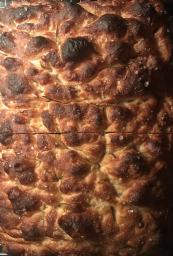I think I know at least 6 different ways of shaping bâtards. I often choose how I shape them on impulse. This weekend, I decided to be a bit more reflective and consciously chose 3 variations to try. I think I gained better control over bâtard shaping as a result.
I made two loaves of Hamelman's Pain au Levain from “Bread” and two loaves of my San Joaquin Sourdough.
The first loaf was shaped using one of the methods learned from the San Francisco Baking Institute. I can't recall seeing this method demonstrated elsewhere.

Pain au Levain from Hamelman's "Bread," shaped using Method 1.
Method 1
Pre-shape as a log. Rest 20 minutes, seam side up, covered.
Place the piece on the board with one short side closest to you. De-gas.
Take the far edge and fold it towards you about 1/3 of the length of the piece. Seal the seams.
Fold the left side 1/3 of the way towards the middle and seal the seams. Repeat for the right side.
Starting with the far end, roll the piece towards you, sealing the seam with the edge or heel of your hand at each turn. Seal the final seam well.
Turn the loaf seam side down and roll it to even out the shape and achieve the desired length.
This method is suitable to make a bâtard with a fat middle and little tapering, as pictured.

Pain au Levain from Hamelman's "Bread," shaped using Method 2.
Method 2
Pre-shape as a log. Rest 20 minutes, seam side up, covered.
Place the piece on the board with a wide side closest to you. De-gas.
Fold the far side to the middle. Seal the seam.
Rotate the piece 180º.
Fold the far side 2/3 of the way towards you. Seal the seam.
Grasp the far edge and bring it all the way over the piece, to the board and seal the seam. (Essentially, this is the method traditionally used to shape baguettes.)
Turn the loaf seam side down and roll it to even out the shape and achieve the desired length.
This method makes a longer, thinner loaf with more tapered ends.

The two loaves of Pain au Levain after shaping and scoring - ready to bake. Note that these loaves were of identical weight.

San Joaquin Sourdoughs, both shaped using Method 3.
Method 3
Pre-shape as a ball. Rest 20 minutes, seam side up, covered.
Place the piece on the board. De-gas.
Proceed as in Method 2, steps 3 through 7.
This method results in a loaf similar to that from using Method 2, except a bit thicker in the middle. It solves a problem I have had shaping bâtards with higher-hydration doughs with excessive extensibility. They tend to get too long and thin as I shape them, even before the final rolling out. Starting with a round piece of dough, rather than a log, helps me get the shape I want.

Thanks for listening.
Happy Baking!
David














